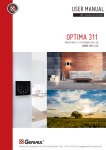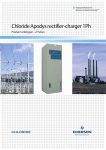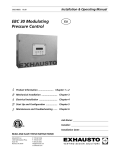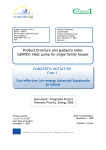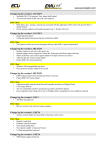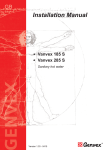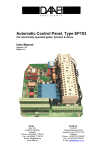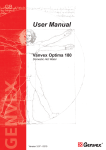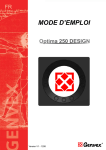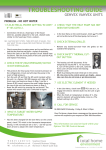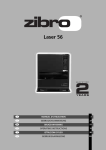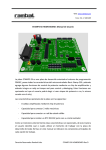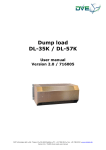Download OPTIMA 100 OPUS OPTIMA 100 DESIGN
Transcript
USER MANUAL UK / Version 23.09.2014 OPTIMA 100 OPUS OPTIMA 100 DESIGN PCB ES951 Version 2012.02.28 GES ENERGY 1, GES ENERGY S/M, GE ENERGY 1/2/3 Genvex A/S • Sverigesvej 6 • DK-6100 Haderslev • Tel.: +45 73 53 27 00 • [email protected] • genvex.dk Table of contents Page 1. Mounting Design......................................................3 1.1 Installation of the control panel.................................3 1.2 Mounting...................................................................3 2. Mounting Opus.........................................................4 2.1 Installation of the control panel.................................4 2.2 Mounting...................................................................4 3. Operation..................................................................5 3.1 Use and changing of the settings.............................5 3.2 Ventilator Speed.......................................................5 3.3 Filter alarm...............................................................6 3.4 Bypass......................................................................7 3.5 Electrical Heating.....................................................7 3.6 Restoring the factory settings...................................8 3.7 Set points’ table........................................................8 4. Function....................................................................8 4.1 Extra capacity...........................................................8 5. Maintenance..............................................................9 5.1 Parts.........................................................................9 5.2 Alarms......................................................................9 5.3 Demounting / taking the system out of operation.....9 6. Troubleshooting.....................................................10 6.1 System does not operate.......................................10 6.2 Fault on the air side................................................10 7. Electrical Diagram..................................................11 2 Subject to technical modifications of Optima 100 1. Mounting Design 1.1 Installation of the control panel The control panel is designed to be mounted onto a flat wall. 1.2 Mounting Find the location on the wall where you will fix the control panel and mark the screw-hole positions. A min. of four screws must be used, the two bottommost and the two topmost. Mandatory Screw Mandatory Screw Screw Screw Mandatory Screw A low-current cable 8 x 0.25 mm2 must be attached between the unit and the control panel. 10 m is the maximum cable length. The voltage drop for cable lengths over 10 m is too high and can result in unreliable operation. How to mount the wall fixture: First screw the fixture securely onto the flat wall and pass the cable up from below. Connect the low-current cable to the terminal block. Check that the cable is connected to the same numbers at both ends. (Between the control panel and the main circuit board in the unit.) Next clip the control panel to the wall fixture by guiding it down from above, slightly slanting out at the bottom. Finish by pressing in at the bottom so that it sits flat against the wall. For demounting: pull the control panel a little out at the bottom and lift up. Mandatory Screw Hold the wall frame against the wall and mark the screw-hole positions. Drilling of holes, hole size and the corresponding screws for fixing the panel depend on the wall material. Place the control panel in the fixtures and tilt it in against the wall. The four support points in the corner of the display must touch the wall to keep the display stable. Support Point Support Point Support Point Support Point Pos. Description 1 Panel housing 2 Front of panel 3 Pressure plate for display 4 Wall fixture 5 Glass for the display A Underneath the control panel there is an access for the: A: Terminal block. Connection to main circuit board Subject to technical modifications of Optima 100 3 2. Mounting Opus 3. Operation 2.1 Installation of the control panel All Genvex GE/S Energy and GEU residential ventilation units can be operated with the Optima 100 control. The control panel is designed to be fitted in the opening of an Opus type plug socket. The Optima 100 control has the following settings: Ventilator speed, filter alarm, bypass ON/OFF and electrical heating ON/OFF. The control unit is supplied with factory set settings that enable the unit to be operated without initially having to change the settings. The factory settings are only basic settings, which can be changed to suit the operational requirements and needs of the building, so that the system can be optimally used and operated. 3.1 Use and changing of the settings 2.2 Mounting Find the location where the control panel is to be placed and connect the lead first then click the control panel in place. Optima 100 Design is operated via the B3, B4 and B5 buttons. Optima 100 Opus is operated via the B3 and B5 buttons. With Opus the B4 button enables the B3 and B5 buttons to be held down at the same time. The button combinations that need to be used to change the ventilator speed, reset the filter alarm and switch on/off the bypass and/or electrical heating are described below. A low-current cable 8 x 0.25 mm2 must be attached between the unit and the control panel. 50 m is the maximum cable length. The voltage drop for cable lengths over 50 m is too high and can result in unreliable operation. Check that the cable is connected to the same numbers at both ends. (Between the control panel and the main circuit board in the unit.) The button to the left of the control panel is B3 and the button on the right is B5. B4, which we know from the Design control panel is, in the case of Opus, just used to hold both buttons down, i.e. B3 and B5 together. 1 B3 4 Subject to technical modifications of Optima 100 2 3 4 B4 B5 3.2 Ventilator Speed Both ventilators can be set independently of each other, so that the airflow at the inlet and outlet are equal, which results in optimal operation. Commissioning of the unit must be carried out using technical equipment for and may be done without the use of a main regulating damper. It is not advised to set the airflow without expert help and guidance. Incorrect settings can result in increased energy use. You must manually select the ventilation unit’s operating level. You can select this with a short press of the button B3. Choose the ventilation speed: Level 0 inlet/outlet airflow: LEDs off – Standby – cannot be set via the display Level 2 outlet airflow Level 2 is the recommended operating level for an optimal indoor climate and should be commissioned to meet the building’s ventilation requirements. To access level 2 from the main display, hold down button B3 for more than 10 seconds until LED D1 begins to flash. Press button B4 once more until LED D2 begins flashing. Outlet airflow can now be set to level 2. If you are already in the ventilator settings menu, just press B4 repeatedly until LED D2 begins flashing. Each press of B3 decreases the level 2 outlet airflow by 1%. Each press of B5 increases the level 2 outlet airflow by 1%. To return to the main display, press button B4 repeatedly until all of the LED’s stop flashing. Level 1 inlet/outlet airflow: LED D1 on – Default 25% (can be changed, see below) Level 3 outlet airflow Level 3 is the highest speed that can be set. It is typically used when there are a lot of people, or there is a lot of activity in the kitchen. Level 2 inlet/outlet airflow: LED D2 on – Default 50% (can be changed, see below) Level 3 inlet/outlet airflow: LED D3 on – Default 75% (can be changed, see below) Level 4 inlet/outlet airflow: LED D4 on – Always operated at 100% and cannot be set By default the system is always operating. If the unit is to be set to Standby, it can only be done via a data logger. Alternatively, the unit can be switched off at the main switch. The procedure for setting the ventilator speed to level 1, 2 and 3 is described below. If no button is activated within 100 seconds in the set-up menu, the control system automatically returns to the main display. Level 1 outlet airflow Level 1 is the lowest speed. This is often used with no-one is at home. To access level 1 from the main display, hold down button B3 for more than 10 seconds until LED D1 begins to flash. Outlet airflow can now be set to level 1. If you are already in the ventilator settings menu, just press B4 repeatedly until LED D1 begins flashing. Each press of B3 decreases the outlet airflow by 1%. Each press of B5 increases the outlet airflow by 1%. To return to the main display, press button B4 repeatedly until all of the LED’s stop flashing. To access level 3 from the main display, hold down button B3 for more than 10 seconds until LED D1 begins to flash. Press button B4 twice more until LED D3 begins flashing. Outlet airflow can now be set to level 3. If you are already in the ventilator settings, just press B4 repeatedly until LED D3 begins flashing. Each press of B3 decreases the level 3 outlet airflow by 1%. Each press of B5 increases the level 3 outlet airflow by 1%. To return to the main display, press button B4 repeatedly until all of the LED’s stop flashing. Sucking out Level 1 inlet airflow Level 1 inlet airflow is to be adjusted to match the level 1 outlet airflow. To access level 1 from the main display, hold down button B3 for more than 10 seconds until LED D1 begins to flash. Press button B4 three times more until LED D1/D5 begin to flash at the same time. Inlet airflow can now be set to level 1. If you are already in the ventilator settings menu, just press B4 repeatedly until LED D1/D5 begin flashing at the same time. Each press of B3 decreases the inlet airflow by 1%. Each press of B5 increases the inlet airflow by 1%. Subject to technical modifications of Optima 100 5 To return to the main display, press button B4 repeatedly until all of the LED’s stop flashing. Level 2 inlet airflow Level 2 inlet airflow is to be adjusted to match the level 2 outlet airflow. To access level 2 from the main display, hold down button B3 for more than 10 seconds until LED D1 begins to flash. Press button B4 four times more until LED D2/D5 begin to flash at the same time. Inlet airflow can now be set to level 2. If you are already in the ventilator settings menu, just press B4 repeatedly until LED D2/D5 begin flashing at the same time. Each press of B3 decreases the level 2 inlet airflow by 1%. Each press of B5 increases the level 2 inlet airflow by 1%. To return to the main display, press button B4 repeatedly until all of the LED’s stop flashing. Level 3 inlet airflow Level 3 inlet airflow is to be adjusted to match the level 3 outlet airflow. To access level 3 from the main display, hold down button B3 for more than 10 seconds until LED D1 begins to flash. Press button B4 five times more until LED D3/D5 begin to flash at the same time. Inlet airflow can now be set to level 3. If you are already in the ventilator settings menu, just press B4 repeatedly until LED D3/D5 begin flashing at the same time. Inlet airflow can now be set to level 3. Each press of B3 decreases the level 3 inlet airflow by 1%. Each press of B5 increases the level 3 inlet airflow by 1%. To return to the main display, press button B4 repeatedly until all of the LED’s stop flashing. 3.3 Filteralarm A built-in filter timer measures the amount of time the unit has operated since the last filter replacement. The filter timer can be set between 1-6, which corresponds with 1-6 months. It is recommended to initially set the filter timer to 3, corresponding to 3 months. If the filters become too dirty during the set period, you can set the filter timer to a lower number of months. On the other hand, if the filters do not require replacement at the end of the set period, you can set the filter timer to a higher number of months. When the filter timer reaches the set period for a filter change, the LED of the current step will begin to flash. When the filters have been changed, the alarm is reset by holding button K4 down for more than 10 seconds. All LEDs will briefly flash. Then the filter alarm is reset. The filter timer is set as described below. 1 month Hold the button B4 down for more than 10 seconds, until LED D1 begins to flash. Then press button B4 to confirm the setting and to return to the main display. 2 months Hold the button B4 down for more than 10 seconds, until LED D1 begins to flash. Then press button B5 once until LED D2 begins to flash. Then press button B4 to confirm the setting and to return to the main display. 3 months Hold the button B4 down for more than 10 seconds, until LED D1 begins to flash. Then press button B5 twice until LED D3 begins to flash. Then press button B4 to confirm the setting and to return to the main display. 4 months Hold the button B4 down for more than 10 seconds, until LED D1 begins to flash. Then press button B5 three times until LED D4 begins to flash. Then press button B4 to confirm the setting and to return to the main display. 5 months Hold the button B4 down for more than 10 seconds, until LED D1 begins to flash. Then press button B5 four times until LED D1/D5 begin to flash. Then press button B4 to confirm the setting and to return to the main display. 6 Subject to technical modifications of Optima 100 6 months Hold the button B4 down for more than 10 seconds, until LED D1 begins to flash. Then press button B5 five times until LED D2/D5 begin to flash. Then press button B4 to confirm the setting and to return to the main display. NB: If there is a filter alarm, the filter timer cannot be set. The filter timer must be reset first, before, it can be set again. 3.6 Restoring the factory settings If the set points that are installed result in the system not operating as expected, and the cause cannot be found, the factory settings can be restored as follows: During start-up of the system hold B4 down so that all five LEDs are flashing. As soon as all five LEDs stay constantly on, the button B4 can be released, and the system’s factory settings are restored. 3.7 Set points´ table 3.4. Bypass Systems that are supplied with a bypass can operate in a so-called summertime mode. The outlet air is let outside the heat recovery circuit in the unit via a valve, so that there is no heat recovery. The temperature of the air that is let into the house is, thus, not heated, but corresponds with the temperature of the air outside. Text: Factory settings: 1 Inlet airflow rate 1 (0-100%) 25 2 Inlet airflow rate 2 (0-100%) 50 3 Inlet airflow rate 3 (0-100%) 75 4 Outlet airflow rate 1 (0-100%) 25 5 Outlet airflow rate 2 (0-100%) 50 6 Outlet airflow rate 3 (0-100%) 75 7 System Stop OFF 8 Timer level 4 OFF 9 Timer level 4 3 10 Filter change 3 11 Filter stop OFF Electrical heating can either be accomplished by a preheating or post-heating element. 12 Frost protection ON 14 Frost protection 1 A pre-heating element ensures that the heat recovery circuit does not freeze with very low outdoor air temperatures. 15 Extra heating OFF 16 Extra heating 0 17 Menu On The bypass function must be manually activated via the display. This is done as per the following: Bypass ON: Do a short press on button B5, so LED D5 stays on. Bypass OFF: If LED D5 is constantly on, do a short press on button B5 until D5 turns off. Bypass is OFF, if LED D5 is not constantly on. 3.5 Electrical Heating A post-heating element further heats the inlet air after it has been heated via the heat recovery process in the system. The heating element must be activated manually via the display. This is done as per the following: Installed settings ON Hard-coded: Level 4 inlet, 100% Level 4 outlet, 100% Hygrostat, as per Optima 250. To activate the menu, hold the button B5 down for more than 10 seconds, until LED D1 begins to flash or the LEDs D1/D2 flash at the same time. Electrical heating ON: LEDs D1/D2 flash at the same time Electrical heating OFF: LED D1 flashes Press button B5 for a short period to change between ON and OFF. Press button B4 to return to the main menu. Subject to technical modifications of Optima 100 7 4. Function G4 = Standard Filter (Coarse filter class G4) F5 = Fine Filter (Fine filter class F5) F7 = Pollen Filter (Fine filter class F7) 4.1 Extra capacity Electrical heating: Bypass is controlled manually by button B5. Bypass: Bypass is controlled manually by button B3. 5. Maintenance For any system controlled by Optima 100, e.g. the Energy range, you must check if LED D5 is constantly lit or if it flashes. If it flashes, it means that the filters in the unit must be changed. For optimal operation, please observe the following points: Before opening the unit, turn off the power/ unplug the unit and wait until the ventilators are completely still. Ventilators: Remember to turn off the power before inspecting the unit!! The fan impellers in the ventilator should be checked for dirt and contaminants every year. Demount the front cover on the unit. Clean the ventilators with a scrubbing brush, bottle brush or duster. NB. Do not remove the balancing weights on the ventilator impellers otherwise this will cause imbalance and result in noisy operation and wear of the ventilators. After the unit has been installed and operating for a couple of days, it should be checked if the condensation outlet is functioning. Inlet and outlet air valves: The valves are to be cleaned using a dry cloth. Ensure that the valve does not rotate as this will alter the airflow. Environmental requirements: If icing occurs or if the unit is to be demounted, the relevant environmental requirements must be followed in association with recycling and disposal of the various materials according to the regulatory requirements. Service: If you are unable to maintain/service your system, you can make a service agreement with the Genvex service department. If there is a fault with the system, please contact the Genvex service department. 5.1 Parts Filters: When LED D5 for the filters in the display is flashing on the control panel, the filters need to be replaced. The unit is stopped via the main switch for the system or via the data-logger. The filters are replaced and the filter timer is reset. If desired, change the filter-replace time period in the menu. It is not recommended to vacuum or use air pressure on the filter, as these will compromise the filtering capability. Cutting hazard: The fins have sharp edges. The fins must not be damaged. 8 Condensate and condensation outlet: The condensation outlet must be checked for blockages and the water trap must be checked for water in association with changing filters before autumn begins. Pour 1 liter of water in the condensation water tray and see if the water drains freely. If the condensation outlet does not work, there is a risk of water damage in the building. 5.2 Alarms Filter timer: The control system has a filter timer to ensure the filters are replaced regularly and the unit operates optimally. At the time when the filter reaches the set value, LED D5 will begin to flash in the display until the filters are changed. 5.3 Demounting / taking the system out of operation The following is to be done: The power must be disconnected from the unit, i.e. the electrical cable is disconnected. Take out the condensation outlet and electrical cables for any pre or post heating. Disconnect leads to the panel and dismantle ducts. If the unit is to be taken out of operation, the ducts must be dismantled to prevent condensation in the system and in the ducts. Close all inlet and outlet air valves. Subject to technical modifications of Optima 100 6. Troubleshooting 6.1 System does not operate System stopped: No light in the display panel even when the button is pushed. Fault: • The fuse in the panel has blown – no power to unit. • One of the fuses on the circuit board has blown. • Loose cable, no power to the unit. • Loose cable between the unit and the operating panel. • “Filter fault” on the unit. Condensate runs out of the unit: Fault: • Condensation outlet blocked with dirt and contaminants. • No water in water trap. • No condensation on the ground due to frost. • The outlet is not sufficiently protected against frost. 6.2 Fault on the air side No inlet air to residence’s rooms. Fault: • Defective ventilator. • Blocked filter. • Dirt and leaves in the fresh air vent in Autumn or snow and ice in Winter. • Control circuit fuse has blown. No outlet air from wet rooms. Fault: • Defective ventilator. • Blocked filter. • Exhaust vent / roof cap is blocked with ice and snow in the Winter. Cold inlet air: Fault: • The counter flow heat exchanger is blocked with dirt or ice. • The extract air ventilator is defective. • The exhaust air filter is blocked. If the fault is not stated above, please contact the person who installed the system or the GENVEX customer centre. Subject to technical modifications of Optima 100 9 ES951 L2 1 2 1 2 3 4 1 2 3 4 5 6 7 8 1 2 3 4 5 1 2 3 4 5 6 7 8 H1 1 Q1=1,6A L1 PE 7. Electrical Diagram L3 2 H3 1 2 1 2 1 2 L4 L6 R2 R4 H7 R1 H8 H9 1 2 3 PE R3 1 N PE Blue 1 230V H7 2 Brown Red Blue M4 1 L6,1 M1 H8 2 +5V GND EC-Fan Exhaust Max 1,0A 2 1 L PE N 4 1 3 4 Electrical Heater/Preheater Yellow 230V 3 K5 6 C4 7 C3 +5V 8 C1 90°C manu Yell/Green 1 K4 24 C2 L3 H3 2 K3 23 5 22 OPTIMA 100 DESIGN 230V 2 21 H1 PE Sensor Heater/Preheater T1 1 T9 L2 2 Sensor Exhaust air 3 T4 PE L1 Mains 1x230VAC, 50Hz MAX Fuse 10A Must be connected to earth 2 L1 2 1 2 3 1 Genvex Hygrostat Potentialfree Contact Must be used Yellow EC-Fan Supply Max 1,0A 10 M2 Blue L6,2 7 Blue 6 5 M1 8 EC-Fan Exhaust Max 1,0A M2 Yellow Subject to technical modifications of Optima 100 Brown Blue 1 230V H9 PE EC-Fan Supply Max 1,0A 2 3 Yell/Green 4 Connection for Dataloging Our Units and Controls – Your Choice Genvex has more than 40 years of experience in creating quality units providing optimum indoor climate with excellent energy efficiency. Our systems employ the newest technologies in heat recovery and have heat recovery rates of up to 96%. The systems are continuously optimised with the newest technologies. Advanced controls ensure that as little energy as possible is used for reaching an optimum level of comfort. Today’s and future construction place greater and greater requirements for energy-friendly, yet compact systems. We at Genvex are aware of this and are continuously developing solutions that meet these needs. For example, a brilliant solution for decentralised housing ventilation is a range hood solution with full integration to the system’s control which ensures that the most efficient ventilation system is achieved with the simplest installation. Genvex A/S • Sverigesvej 6 • DK-6100 Haderslev • Tel.: +45 73 53 27 00 • [email protected] • genvex.dk











